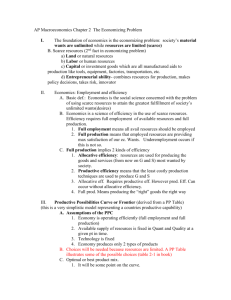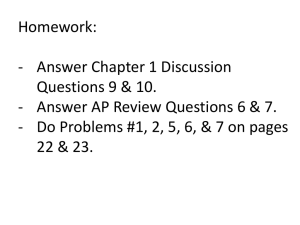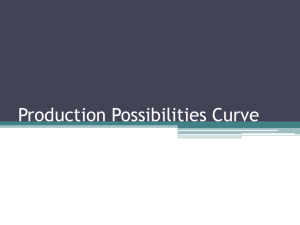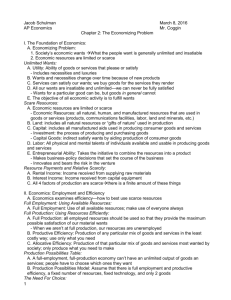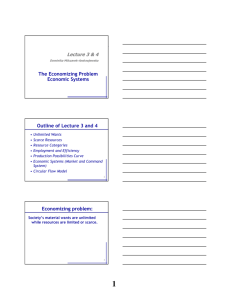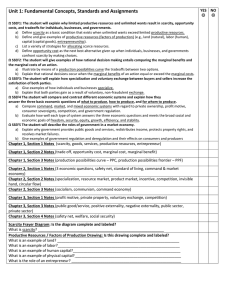Opportunity Cost
advertisement
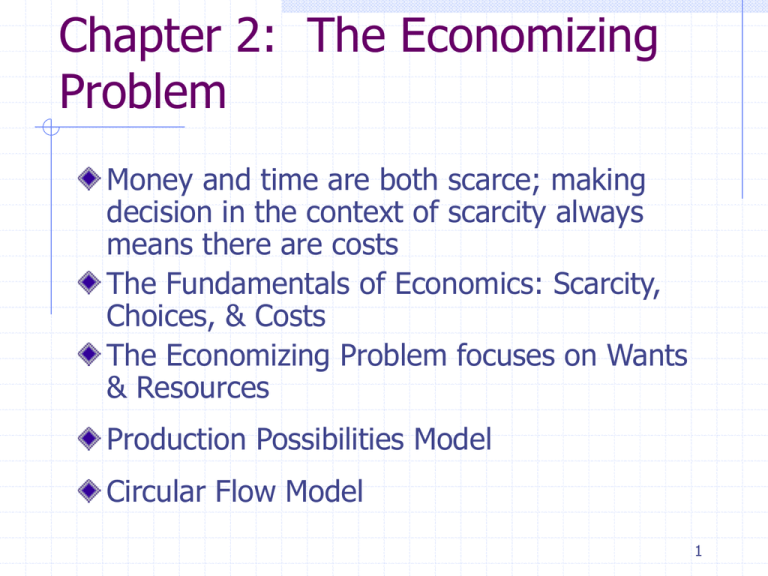
Chapter 2: The Economizing Problem Money and time are both scarce; making decision in the context of scarcity always means there are costs The Fundamentals of Economics: Scarcity, Choices, & Costs The Economizing Problem focuses on Wants & Resources Production Possibilities Model Circular Flow Model 1 The Fundamentals of Economics Two facts constitute the Economizing Problem: 1. 2. Society’s economic wants are unlimited & insatiable Economic resources are limited or scarce 2 Economic Wants Desires of consumers to obtain & use various goods & services that provide UTILITY Necessities Luxuries Over time, wants change & multiply, fueled by new products Business & government also try to satisfy their economic goals The objective of all economic activity is to fulfill wants 3 Scarce Resources Economic resources are limited or scarce. Resources: all natural, human, & manufactured resources in the production of goods & services. Property (Land, Raw Mats, & Capital) Human (Labor & Entrepreneurial) 4 The Factors of Production 1. Land Includes all natural resources used in production process (arable land, forests, mineral & oil deposits, & water resources) 2. Capital (aka Capital/Investment Goods) Includes all manufactured aids used in producing consumer goods & services. Investment is the process of producing & purchasing capital goods 3. Labor All physical & mental talents of individuals available & usable in producing goods & services 4. Entrepreneurial Ability 5 Full Employment Full Employment: Use of all available resources. No workers should be out of work if they are willing & able Land or equipment is not idle 6 Full Production All employed resources should be used to provide maximum possible satisfaction of our wants. Otherwise, underemployed Productive Efficiency: Production of any particular mix of goods & services in the least costly way Allocative Efficiency: Production of a particular mix of goods & services most wanted by society. “Right” mix of goods & services, each produced at lowest possible unit cost. 7 Production Possibilities Model Assumptions: Full Employment & Productive Efficiency Factors of Production are Fixed in Quantity & Quality Can be reallocated, within limits, among different uses Fixed Technology (Short Period of Time) Economy is Producing ONLY Two (2) Goods At any point in time, an economy achieving full employment & productive efficiency must sacrifice some of one good to obtain more of another good. Scarce resources prohibit such an economy from having more of both goods. 8 Production Possibilities Curve Each point on the PPC represents some maximum output of the two products. Production Possibilities Frontier shows the limit of attainable outputs. To obtain the various combinations of goods that fall ON the PPC, society MUST achieve both Full Employment & Productive Efficiency. Points inside are inefficient, undesirable Points outside are unattainable w/ current supply of resources & technology 9 Increasing Opportunity Cost Since resources are scarce relative to virtually unlimited wants, people must choose between alternatives. Opportunity Cost: The amount of other products that must be forgone or satisfied to obtain 1 unit of a specific good. The opportunity cost of each additional unit of a good is greater than the opportunity cost of the preceding one. Opportunity cost is measured in real terms (goods v. money) The more of a product that is produced, the greater its opportunity cost Economic resources are not completely adaptable to alternative uses. Lack of perfect flexibility on the part of resources is cause of increasing OC. 10 Unemployment & Productive Inefficiency In the presence of unemployment or inefficiency, the economy would produce less Represented by points inside the original PPC A move toward full employment & productive efficiency would yield a greater output of one or both products. 13 A Growing Economy: Increase in Resource Supplies E.g.: Size of Labor Increases (Growing Population, Immigration) Quality of Labor improves over time Greater abundance of resources results in greater potential output of one or both products at each alternative on the PPC. Economic growth is achieved in the form of an expanded potential output. 14 A Growing Economy: Advances in Technology Technology progresses over time Advanced technology brings new & better goods AND improved ways of producing them Technological advances allows society to produce more goods with fixed resources. 15 A Growing Economy When the supplies of resources increase or there is improvement in technology, the Production Possibilities Curve SHIFTS OUT An outward shift of the PPC represents growth of economic capacity Economic Growth: The ability to produce larger total output. While static, no-growth economy must sacrifice some of one product in order to get more of another, a dynamic, growing economy can have larger quantities of both products 16 International Trade Production Possibilities Model implies that an individual nation is limited to the combinations of output indicated by its PPC. Through specialization & trade, the output limits imposed by its domestic PPC can be avoided. International Specialization: Directing domestic resources to make what a nation is highly efficient at producing. International Trade: the exchange of specialized goods for goods produced abroad. International specialization & trade enable a nation to obtain more goods than its PPC indicates. 18 Economic Systems Every society develops an economic system, a particular set of institutional arrangements and a coordinating mechanism, to respond to the economizing problem. Economic systems differ depending on: 1. 2. Who owns the factors of production The method used to coordinate & direct economic activity 19 The Market System (Capitalism) Characterized by the private ownership of resources and the use of markets & prices to coordinate and direct economic activity Each participant acts in their own self-interest Each individual/business seeks to maximize satisfaction/profit Private ownership of capital Communicates through Prices Coordinates activity through Markets: where buyers & sellers come together Competition among independent buyers & sellers of each product 20 The Command System (Socialism/Communism) Government owns most property resources Government makes economic decisions Use of resources, composition & distribution of output, organization of production Division of output between capital & consumer goods is centrally decided 21 The Circular Flow Model Decision Makers: Households (people) own all economic resources directly or indirectly Businesses buy resources necessary for producing goods & services; Wages, rent, interest & profit income (money) flows back to households 22 The Circular Flow Model Markets: Resource: where resources or services are bought & sold Product: where goods & services produced by businesses are bought & sold. Businesses combine resources to make products they sell Households use income to buy goods & services Monetary flow of consumer spending yields revenues for businesses 23 Chapter 2 Study Questions 5: Productive Efficiency & Allocative Efficiency 6: Production Possibilities Curve 9: Marginal Benefit & Cost 10: Production Possibilities Curve 12: PPC 16: Circular Flow Model 17: Women & Expanded Production Possibilities 25

